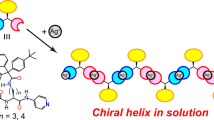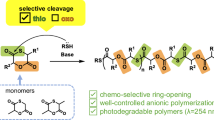Abstract
Effects from various initial molar ratios of aniline (AN), ammonium peroxydisulfate (APS) and HCl ([AN]:[APS]:[HCl]) on the polymerization of AN were investigated. First, a scheme derived from a molecular point of view was proposed to distinguish formation mechanisms based on their initial conditions. Thereafter, by choosing a relatively low ratio of [APS]/[AN]=0.23 at [AN]=0.27 M, three cases can be categorized according to this scheme: (A) [AN]≫[HCl], (B) [AN] slightly larger than [HCl] and (C) [AN]<[HCl]. For case (A), the initial solution has a richness of neutral ANs. Both the doped and the dedoped samples are confirmed to have features of phenazine-like oligomers. For case (C), neutral ANs are almost protonated to become anilinium cations. The final products possess features of polyaniline. For case (B), the samples possess both features from cases (A) and (C). Finally, the formation mechanisms for polymerization of AN were discussed.
Similar content being viewed by others
Log in or create a free account to read this content
Gain free access to this article, as well as selected content from this journal and more on nature.com
or
References
Moliton, A. & Hiorns, R. C. Review of electronic and optical properties of semiconducting π-conjugated polymers: applications in optoelectronics. Polym. Int. 53, 1397–1412 (2004).
Heeger, A. J. Semiconducting and metallic polymers: the fourth generation of polymeric materials. Synth. Met. 125, 23–42 (2002).
Chiang, J. C. & MacDiarmid, A. G. ‘Polyaniline’: protonic acid doping of the emeraldine form to the metallic regime. Synth. Met. 13, 193–205 (1986).
Stejskal, J., Kratochvil, P. & Jenkins, A. D. The formation of polyaniline and the nature of its structures. Polymer 37, 367–369 (1996).
Gospodinova, N., Terlemezyan, L., Mokreva, P. & Kossev, K. On the mechanism of oxidative polymerization of aniline. Polymer 34, 2434–2437 (1993).
Gospodinova, N., Mokreva, P. & Terlemezyan, L. Chemical oxidative polymerization of aniline in aqueous medium without added acids. Polymer 34, 2438–2439 (1993).
Gospodinova, N. & Terlemezyan, L. Conducting polymers prepared by oxidative polymerization: polyaniline. Prog. Polym. Sci. 23, 1443–1484 (1998).
Tzou, K. & Gregory, R. V. Kinetic study of the chemical polymerization of aniline in aqueous solutions. Synth. Met. 47, 267–277 (1992).
Ciric-Marjanovic, G., Trchova, M. & Stejskal, J. Theoretical study of the oxidative polymerization of aniline with peroxydisulfate: tetramer formation. Int. J. Quantum. Chem. 108, 318–333 (2008).
Zujovic, Z. D., Zhang, L., Bowmaker, G. A., Kilmartin, P. A. & Travas-Sejdic, J. Self-assembled, nanostructured aniline oxidation products: a structural investigation. Macromolecules 41, 3125–3135 (2008).
Stejskal, J., Sapurina, I. & Trchova, M. Polyaniline nanostructures and the role of aniline oligomers in their formation. Prog. Polym. Sci. 35, 1410–1481 (2010).
Trchova, M., Sedenkova, I., Konyushenko, E. N., Stejskal, J., Holler, P. & Ciric-Marjanovic, G. Evolution of polyaniline nanotubes: the oxidation of aniline in water. J. Phys. Chem. B 110, 9461–9468 (2006).
Sapurina, I. & Stejskal, J. The mechanism of the oxidative polymerization of aniline and the formation of supramolecular polyaniline structures. Polym. Int. 57, 1295–1325 (2008).
Stejskal, J., Sapurina, I., Trchova, M. & Konyushenko, E. N. Oxidation of aniline: polyaniline granules, nanotubes, and oligoaniline microspheres. Macromolecules 41, 3530–3536 (2008).
Huang, Y. F. & Lin, C. W. Introduction of methanol in the formation of polyaniline nanotubes in an acid-free aqueous solution through a self-curling process. Polymer 50, 775–782 (2009).
Venancio, E. C., Wang, P. C. & MacDiarmid, A. G. The azanes: a class of material incorporating nano/micro self-assembled hollow spheres obtained by aqueous oxidative polymerization of aniline. Synth. Met. 156, 357–369 (2006).
Zhang, L., Zujovic, Z. D., Peng, H., Bowmaker, G. A., Kilmartin, P. A. & Travas-Sejdic, J. Structural characteristics of polyaniline nanotubes synthesized from different buffer solutions. Macromolecules 41, 8877–8884 (2008).
Zujovic, Z. D., Laslau, C., Bowmaker, G. A., Kilmartin, P. A., Webber, A. L., Brown, S. P. & Travas-Sejdic, J. Role of aniline oligomeric nanosheets in the formation of polyaniline nanotubes. Macromolecules 43, 662–670 (2010).
Ding, H., Shen, J., Wan, M. & Chen, Z. Formation mechanism of polyaniline nanotubes by a simplified template-free method. Macromol. Chem. Phys. 209, 864–871 (2008).
Konyushenko, E. N., Trchova, M., Stejskal, J. & Sapurina, I. The role of acidity profile in the nanotunular growth of polyaniline. Chem. Pap. 64, 56–64 (2010).
Laslau, C., Zujovic, Z. D., Zhang, L., Bowmaker, G. A. & Travas-Sejdic, J. Morphological evolution of self-assembled polyaniline nanostuctures obtained by pH-stat chemical oxidation. Chem. Mater. 21, 954–962 (2009).
Li, G., Pang, S., Xie, G., Wang, Z., Peng, H. & Zhang, Z. Synthesis of radially aligned polyaniline dendrites. Polymer 47, 1456–1549 (2006).
Li, G., Zhang, C., Li, Y., Peng, H. & Chen, K. Rapid polymerization initiated by redox initiator for the synthesis of polyaniline nanofibers. Polymer 51, 1934–1939 (2010).
Ding, Z., Currier, R. P., Zhao, Y. & Yang, D. Self-assembled polyaniline nanotubes with rectangular cross-sections. Macromol. Chem. Phys. 210, 1600–1606 (2009).
Wang, J., Wang, J., Yang, Z., Wang, Z., Zhang, F. & Wang, S. A novel strategy for the synthesis of polyaniline nanostructures with controlled morphology. React. Funct. Polym. 68, 1435–1440 (2008).
Pan, L., Pu, L., Shi, Y., Sun, T., Zhang, R. & Zheng, Y. Hydrothermal synthesis of polyaniline mesostructures. Adv. Funct. Mater. 16, 1279–1288 (2006).
Ohira, M., Sakai, T., Takeuchi, M., Kobayashi, Y. & Tsuji, M. Raman and infrared spectra of polyaniline. Synth. Met. 18, 347–352 (1987).
Shao, L., Qiu, J. H., Feng, H. X., Liu, M. Z., Zhang, G. H., An, J. B., Gao, C. M. & Liu, H. L. Structural investigation of lignosulfonate doped polyaniline. Synth. Met. 159, 1761–1766 (2009).
Komura, T., Ishihara, M., Yamaguchi, T. & Takahashi, K. Charge-transporting properties of electropolymerized phenosafranin in aqueous media. J. Electroanal. Chem. 493, 84–92 (2000).
Surwade, S. P., Dua, V., Manohar, N., Manohar, S. K., Beck, E. & Ferraris, J. P. Oligoaniline intermediates in the aniline-peroxydisulfate system. Synth. Met. 159, 445–455 (2009).
Bailey, G. W. & Karickhoff, S. W. An ultraviolet spectroscopic method for monitoring surface acidity of clay minerals under varying water content. Clays Clay Miner. 21, 471–477 (1973).
Zhang, W. J., Feng, J., MacDiarmid, A. G. & Epstein, A. J. Synthesis of oligomeric anilines. Synth. Met. 84, 119–120 (1997).
Hung, J., Virji, S., Weiller, B. H. & Kaner, R. B. Polyaniline nanofibers: facile synthesis and chemical sensors. J. Am. Chem. Soc. 125, 314–315 (2003).
Xia, Y., Wiesinger, J. M., MacDiarmid, A. G. & Epstein, A. J. Camphorsulfonic acid fully doped polyaniline emeraldine salt: conformations in different solvents studied by an ultraviolet/visible/near-infrared spectroscopic method. Chem. Mater. 7, 443–445 (1995).
Polk, B. J., Potje-Kamloth, K., Josowicz, M. & Janata, J. Role of protonic and charge transfer doping in solid-state polyaniline. J. Phys. Chem. B 106, 11457–11462 (2002).
Kulszewicz-Bajer, I., Rozalska, I. & Kurylek, M. Synthesis and spectroscopic properties of aniline tetramers. New. J. Chem. 28, 669–675 (2004).
Long, S. M., Brenneman, K. R., Saprigin, A., Kohlman, R. S., Epstein, A. J., Angelopoulos, M., Buchwalter, S. L., Rossi, A., Zheng, W. & MacDiarmid, A. G. Aggregation and interchain ‘self’ doping in emeraldine base. Synth. Met. 84, 809–810 (1997).
Hammond, R. B., Roberts, K. J., Smith, E. D. L. & Docherty, R. Application of a computational systematic search strategy to study polymorphism in phenazine and perylene. J. Phys. Chem. B 103, 7762–7770 (1999).
Nechtschein, M., Santier, C., Travers, J. P., Chroboczek, J., Alix, A. & Ripert, M. Water effects in polyaniline: NMR and transport properties. Synth. Met. 18, 311–316 (1987).
Tang, S. J., Lin, S. M., Chiu, K. C., Wu, Y. Y. & Yeh, J. M. Effects of dynamic vacuum- pumping and temperature dependence of dark electrical conductivity in polyaniline films made by various pressing pressures. J. Phys. D: Appl. Phys. 41, 125401 (2008).
Kriz, J., Starovoytova, L., Trchova, M., Konyushenko, E. N. & Stejskal, J. NMR investigation of aniline oligomers produced in the early stages of oxidative polymerization of aniline. J. Phys. Chem. B 113, 6666–6673 (2009).
Pouget, J. P., Jozefowicz, M. E., Epstein, A. J., Tang, X. & MacDiarmid, A. G. X-ray structure of polyaniline. Macromolecules 24, 779–789 (1991).
Kahol, P. K., Pinto, N. J., Berndtsson, E. J. & McCormick, B. J. Electron localization effects on the conducting state in polyaniline. J. Phys. Condens. Matter. 6, 5631–5638 (1994).
Wei, Y., Hariharan, R. & Patel, S. A. Chemical and electrochemical copolymerization of aniline with alkyl ring-substituted anilines. Macromolecules 23, 758–764 (1990).
Chen, L., Sun, L. J., Luan, F., Liang, Y., Li, Y. & Liu, X. X. Synthesis and pseudocapacitive studies of composite films of polyaniline and manganese oxide nanoparticles. J. Power Sources 195, 3742–3747 (2010).
Yoshikawa, H., Hino, T. & Kuramoto, N. Effect of temperature and moisture on electrical conductivity in polyaniline/polyurethane (PANI/PU) blends. Synth. Met. 156, 1187–1193 (2006).
Cristovan, F. H., Lemos, S. G. & Pereira, E. C. Systematic evaluation of the preparation of conducting PANI/ABS blends. J. Appl. Polym. Sci. 116, 825–831 (2010).
Acknowledgements
This study was supported by the National Science Council of the Republic of China. We thank Professor W L Abels and Mrs C H Abels for their editorial assistance.
Author information
Authors and Affiliations
Corresponding author
Rights and permissions
About this article
Cite this article
Tang, SJ., Wang, AT., Lin, SY. et al. Polymerization of aniline under various concentrations of APS and HCl. Polym J 43, 667–675 (2011). https://doi.org/10.1038/pj.2011.43
Received:
Revised:
Accepted:
Published:
Issue date:
DOI: https://doi.org/10.1038/pj.2011.43
Keywords
This article is cited by
-
Intertwining porous silicon with conducting polymer for high-efficiency stable Li-ion battery anodes
Korean Journal of Chemical Engineering (2023)
-
Surface modification of recycled fabric materials with conductive polyaniline and its role in organic matter adsorption
International Journal of Environmental Science and Technology (2022)
-
Visible light-induced photocatalytic and antibacterial activity of TiO2/polyaniline-kapok fiber nanocomposite
Polymer Bulletin (2022)
-
Effect of polyaniline content and protonating dopants on electroconductive composites
Scientific Reports (2021)
-
Preparation of polyaniline nanomatrix formed in natural rubber
Polymer Journal (2020)



